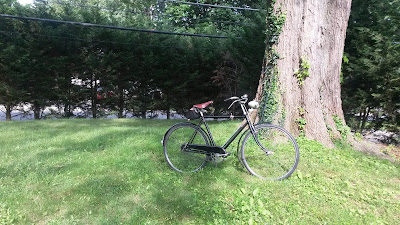During the 1950s, 60s, and early 70s, Sturmey Archer produced a three speed coaster brake called the "TCW" hub, in various forms (TCW, TCW II, III, and IV). The hub essentially is a very close kin to the reliable Sturmey AW three speed (very close, but many parts will not interchange), but with a coaster brake grafted onto the non-drive side. The general consensus of many vintage bike experts has long been that the TCW is
an unreliable, poorly engineered hub.
I have rebuilt several of these hubs and ride one several times weekly on my
Hercules Model C . The hub certainly has some flaws, but it is not the unmitigated disaster that some online have described. In fact, the hub is generally pleasant once set up properly. It is not as unsafe as some allege when used in conjunction with a front brake. While I do not advise using it as your
only brake, I do think a properly set up TCW is perfectly functional in combination with a front brake.
The Two Major Flaws and Solutions
The TCW series has a couple flaws in the design, true. These are: (1) driving the brake through the transmission, thereby allowing the 'neutral' position to disable the brake and (2) the reliance on a fragile "E-clip" to ensure the transmission side of the hub remains in place.
Both of these problems can be mitigated. The first issue is mainly an adjustment issue. Properly adjusting the shifter cable can help ensure the brake remains activated and the hub stays in gear when you're shifting. The other byproduct of the first flaw is that the brakes tender to be a bit 'weaker' in third gear because of the gear ratio applied by the transmission. However, I have noticed the brake still slows and stops the bike, even in third. The logical solution here is to make sure you have a front hand brake on your bicycle, which is something you probably should have anyway on a coaster brake bicycle with multiple gears.
The second flaw is a bit more insidious. The TCW hub needs the transmission to stay on its half of the hub shell and axle, and not to slip around or migrate toward the brake. If it does migrate, third gear may not engage probably, preventing the high gear from powering the bicycle and preventing the brake from working in third gear. This usually happens when the E-clip is weakened or loose, and the slamming of the clutch into high gear drives the E-clip out of its axle slot.
The way to remedy this is to replace the E-clip, or else slightly tighten it using care and small pair of pliers (be very careful doing this). What I do is completely tear down the hub to the axle, then remove the E-clip. I then tighten the clip in the plier jaws and snap it back into its axle slot. The result is a noticeably tighter e-clip that keeps the transmission components in place. Remember too that if you do have the transmission migrate in this way, low and medium will very likely still work fine, so this will at least get you home and allow braking in the two lower gears. Again, it's also a good idea here to have a front brake.
Other Thoughts
The TCW's other issue is that it relies on a rather small brake sleeve. The way the brake works is essentially as an expanding cuff driven open by a wedge when the rider pedals backwards. The expander thus rubs on the inside of the hub shell and slows the bike. With a very slender expander, the brakes are a bit anemic. This is not really a "flaw" that causes a malfunction in the hub, but it is a weakness that necessitates a front brake to help stop the bike in an emergency. Again, the TCW in this case is actually not bad when used in conjunction with a front brake.
I also like the composition of the brake expander. The metal is softer than the hub material by enough to keep the brake action smooth and not "jerky", while it is still hard enough not to wear excessively. I have several such expander brake sleeves with quite a few miles on them, and the wear is not bad at all.
Closing Thoughts
I will grant that the TCW series of hubs, especially the earlier models, are not as reliable or strong as a modern Sturmey coaster. However, the hubs are not nearly as bad as some make them out to be.
First, learn how the hub works. There are some excellent tutorials online on them, including
Youtube videos. Second, fault check the hub when you get it. Don't try to ride an unknown hub straight off.
Third, do not be afraid to get into the hub and rebuild it. The TCWs I have are all ones I have rebuilt, which made a big difference in the smoothness and brake functioning of the hub. Often an old hub doesn't work because it needs a cleaning and refreshing, rather than having a mechanical failure.
Finally, always use the hub with a front brake. The TCW series can perform reasonably for a vintage hub, but really should not be used alone. They're not nearly robust enough for downhill riding, unless they have help from a front brake. However, for recreational riding on reasonable terrain, they can be enjoyable and functional, if imperfect, if you are careful and pay attention to their details.
 The New World is much lighter and quicker than the 1948 Raleigh Dawn, which is closer to a full roadster, with rod brakes and a chain case.
The New World is much lighter and quicker than the 1948 Raleigh Dawn, which is closer to a full roadster, with rod brakes and a chain case.








































